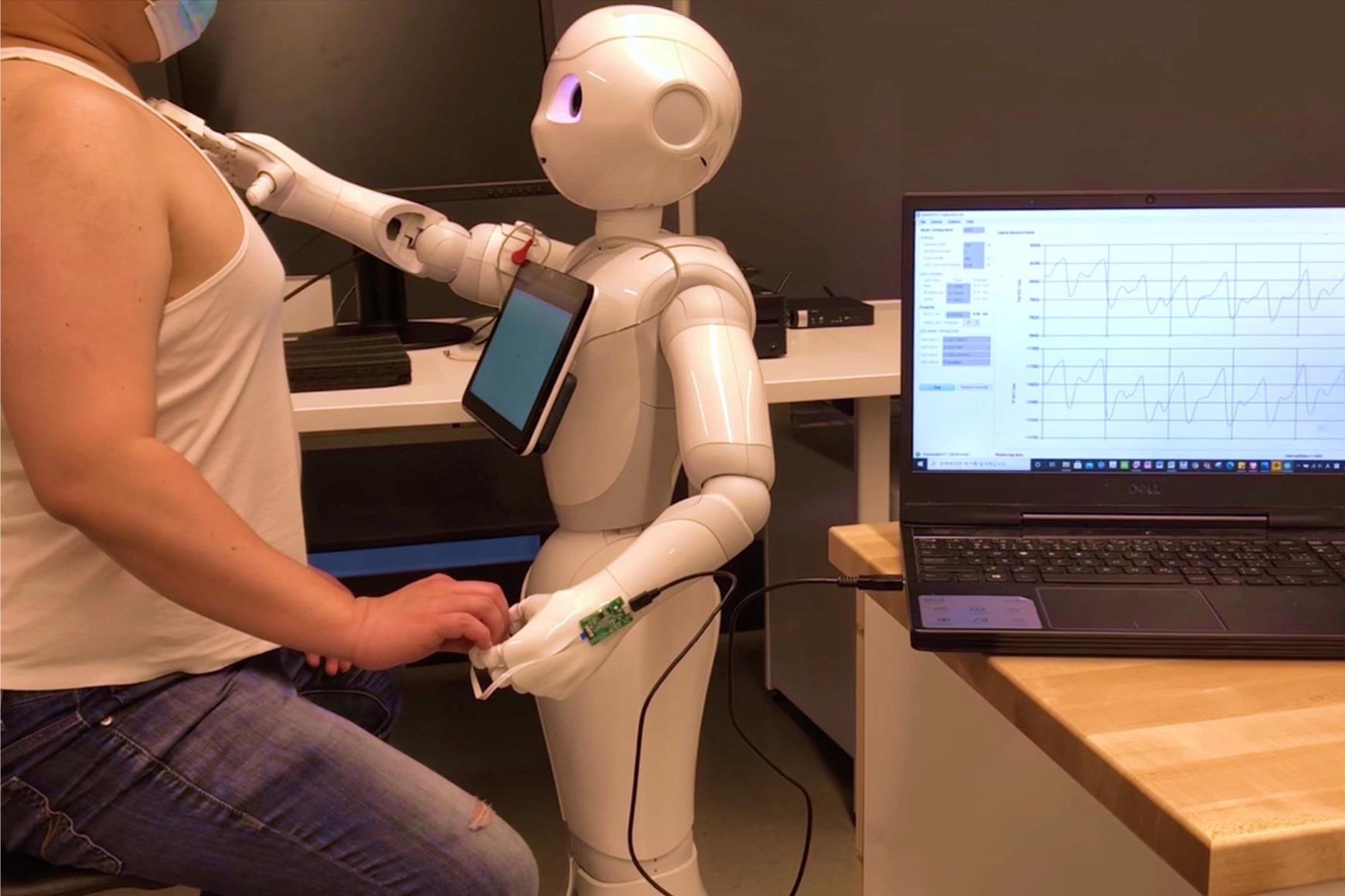Canadian researchers have developed a dry electrode inspired by origami and leeches that fits neatly into the fingers of a humanoid-sensing robot while monitoring blood pressure in patients. The leech-inspired origami (LIO) electrocardiogram (ECG) sensor ensures reliable ECG signals.
 Image Credit: Simon Fraser University. (2022). Robots that can check your blood pressure are the latest innovation from SFU. [online] Available at: https://www.sfu.ca/content/sfu/sfunews/stories/2022/02/robots-that-can-check-your-blood-pressure-are-the-latest-innovat.html
Image Credit: Simon Fraser University. (2022). Robots that can check your blood pressure are the latest innovation from SFU. [online] Available at: https://www.sfu.ca/content/sfu/sfunews/stories/2022/02/robots-that-can-check-your-blood-pressure-are-the-latest-innovat.html
With an increasing demand for remote healthcare monitoring, traditional wet-type electrodes and sphygmomanometers (blood pressure monitors) present several challenges. The cuffless LIO sensor opens up new avenues for remote healthcare monitoring.
In keeping with nature, we saw that in addition to the complex mechanisms of a leech’s adhesive feature, these creatures have an expandable posterior sucker and body, while its organs expand and shrink appropriately to maintain better adhesion to its victim. Incorporating this point of view, we found that origami can achieve similar motions and also be customized.
Woo Soo Kim, Associate Director, School of Mechatronic Systems Engineering, Simon Fraser University
A Brief Introduction to Remote Patient Monitoring
A remote patient monitoring device uses digitally-enabled hardware to capture healthcare data for assessment by remotely based professionals.
The social isolation brought about by the COVID-19 pandemic made clear the demand for remote healthcare monitoring. In fact, some remote monitoring devices were able to measure oxygen saturation levels of patients who were having to isolate at home.
Healthcare professionals are well aware of the economic and social benefits of preventing disease. Remote physiological monitoring allows these professionals to identify issues early while also providing a better quality of care to patients.
Common remote patient monitoring devices include blood pressure monitors, blood sugar level monitors, fertility monitors and surveillance monitors for the disabled.
An app-enabled mobile device is all that is needed to transmit healthcare data. Furthermore, this data can be easily integrated into electronic health records to increase productivity. Additionally, patients have ready access to their healthcare data which helps them improve their lifestyle. A further benefit is that healthcare professionals can use these mobile devices to communicate with their patients.
Designing a Remote Monitoring Sensing Robot
The researchers, based at Simon Fraser University in Canada, developed a bio-inspired sensor for monitoring the blood pressure of patients. Inspired by origami in its geometry and leeches in its functionality, the leech-inspired origami (LIO) sensor combines electrocardiography (ECG) and photoplethysmography (PPG) to perform its functions.
Blood pressure monitoring systems that rely on pulse arrival time (PAT) sensing require ECG (electrical activity) signals near the location of the heart and PPG (blood volume) signals at a distal site. Dry ECG electrodes that avoid the skin irritation associated with wet type electrodes and remain in place on the skin are essential.
The auxetic geometrical design of the LIO sensor was inspired by leeches. An auxetic structure becomes thicker when stretched in a direction perpendicular to the force being applied.
When preparing to suck the blood of their prey, leeches expand the surface area of their mouths while contracting their bodies. During sucking, their mouths contract while their bodies expand. In other words, they combine auxetic and non-auxetic behaviors into their functions. In fact, origami structures also exhibit these auxetic and non-auxetic behaviors.
Origami structures display force direction-shifting properties such as bending and rotating under the influence of an axial force. However, the faces of these structures are hardly affected, making them ideal sites for sensing units.
Thus, the sucking capabilities and the structural properties of origami were combined into a single functional dry electrode sensing unit.
Serpentine-shaped electrodes were 3D printed onto the sensor to ensure stability during the expansion and contraction of the sensor. The LIO sensors were then fitted into the middle fingers of a humanoid robot.
The voice command “check” triggered the operation of the robot. After ensuring there were not any obstacles obstructing its movement, the robot searched for a pulse. Once it had found a pulse, it took ECG measurements for 30 seconds and displayed the results on a tablet.
The robot performed a blood pressure measurement on a human subject’s chest by feeling for a pulse. It maintained contact with the chest during several ECG readings. No damage was observed on the sensors.
The researchers recorded a signal-to-noise ratio of 21.7 ± 0.56 dB on the LIO sensor. This compared to the 18.1 ± 0.85 dB observed on a wet electrode.
Blood pressure monitoring without the use of cuffs found in conventional sphygmomanometers is more comfortable - and convenient - for patients.
With an aging population and the increased demand for remote health monitoring highlighted by the COVID-19 pandemic, sensing robots tied to monitoring devices, such as the leech-inspired origami (LIO) sensor, are opening up new opportunities in remote healthcare.
Blood pressure monitoring is an essential medical diagnostic tool for many chronic diseases and overall good health. The use of sensing robots in medical healthcare systems has substantial advantages because they can assist health care workers in monitoring patient vital signs while creating a friendly environment for those patients who may need to be isolated.
Woo Soo Kim, Associate Director, School of Mechatronic Systems Engineering, Simon Fraser University
References and Further Reading
Kim, W. S., et. al., (2022) 3D printed leech-inspired origami dry electrodes for electrophysiology sensing robots. npj Flexible Electronics, [online] 6, 5. Available at: https://www.nature.com/articles/s41528-022-00139-x
Simon Fraser University. (2022). Robots that can check your blood pressure are the latest innovation from SFU. [online] Available at: https://www.sfu.ca/content/sfu/sfunews/stories/2022/02/robots-that-can-check-your-blood-pressure-are-the-latest-innovat.html
Disclaimer: The views expressed here are those of the author expressed in their private capacity and do not necessarily represent the views of AZoM.com Limited T/A AZoNetwork the owner and operator of this website. This disclaimer forms part of the Terms and conditions of use of this website.